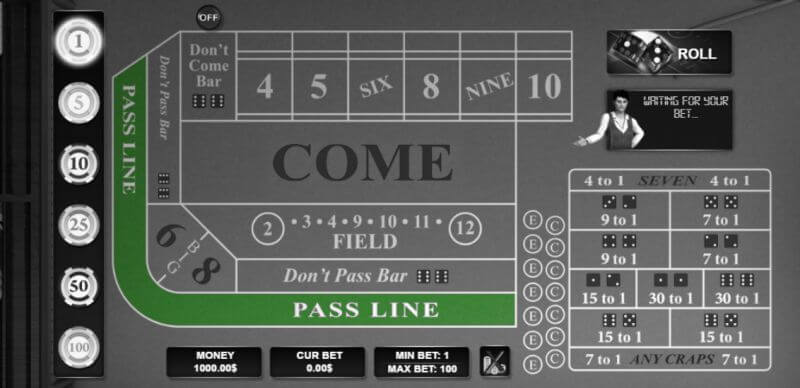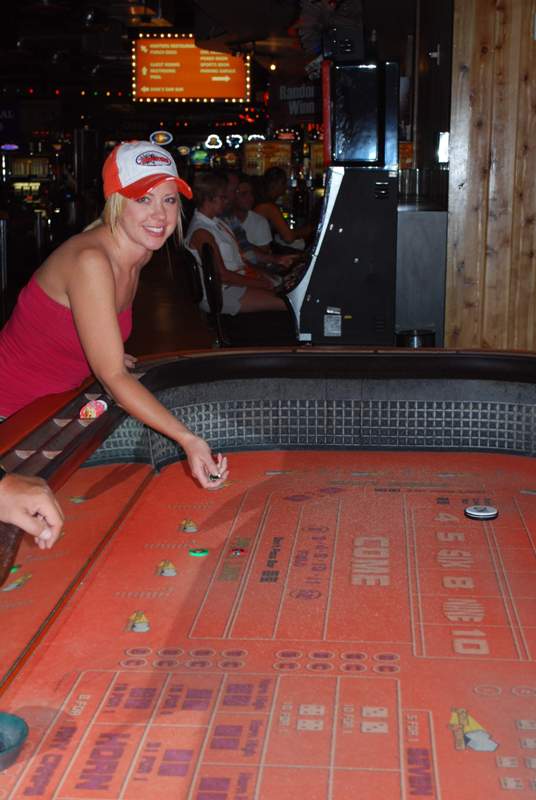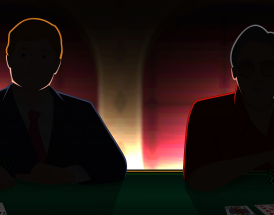Hop 7 Bet Craps
- Hop 7 Bet Craps Games
- Hop 7 Bet Craps Rules
- Hop 7 Bet Craps Picks
- Hop 7 Bet Craps Poker
- Hop 7 Bet Craps Rules
The technical and unsettled explanation of a hop bet. The technical definition of a hop bet is more debated. There are some who would argue that, by definition, a hop bet must have either one combination (the hard hop) or two combinations (the easy hop). For example, is the Big Red (Any 7) or the Any Craps bet considered a hop bet? The payout odds for winning wagers are 7 to 1. CRAPS/11 SPLIT (C&E) A C&E is a one roll combination bet on the Any Craps and 11. If Craps rolls, it pays 3 times the total bet. If 11 rolls, it pays 7 times the total bet. The bet is made in even increments. ANY SEVEN BET Any Seven Bet is a one roll bet. If a 7 is rolled, the bet wins. The bet: Hop 7s pays 15:1 per 7 combination, or 5:1. A $30 Hop 7s pays $150 + the winning $10 bet remains (-$20 on two losing bets). The worst paying instance is when the bet hits on the 9th number rolled. This means you have bet $30, $30, $30, $30, $30. The return is $160, for $150 bet. The 5 paying results are +$130, $100, $70, $40, $10 profits.
Playing a 'Hopping 7Â’s' Progression

By Jerry 'Stickman'
Periodically people ask me about craps betting systems. Almost all of them rely on the premise that certain numbers are due because they havenÂ’t appeared for a while. I normally tell them that in a random you cannot beat the math of the game. The house edge is the house edge. In the long term you will lose the amount of money played times the house edge.
For many that is enough, but every so often someone says they have won a lot of money on a particular system and want me to look further into it. So periodically I will devote an article to exploring some of these systems.
This article will look at a 'Hopping 7Â’s' progression.
Here is the system as it was stated to me.
- Start over with each new shooter.
- Wait seven rolls before starting the progression
- When the bet hits, take the bet down along with the win.
- Start with a $3 bet. Starting with the first bet, the progression is: 3, 3, 6, 9, 15, 24, 39, etc. always adding the previous two bets together to determine the next bet in the progression.
Here is a table that shows the bet, amount invested, win amount (taking the bet down), and profit.
What we have here is a Fibonacci progression. This and the Martingale progression are well known in betting systems. In 'up as you lose' progressions, the thought is that when your number hits you will recoup your losses and garner a little profit. The Fibonacci progression is the less aggressive of the two.
Either of these progressions works as long as two things are true. The first is you must have adequate bankroll to make it through the inevitable losing streaks you will encounter. The amount you require can be very substantial. The last row in the above table represents the 17th roll without a 7. While 17 rolls without a 7 appearing may be somewhat unusual, it is not that uncommon.
If the shooter goes 20 rolls without a 7 appearing, the bankroll required is almost $2,000.
Hop 7 Bet Craps Games
If the shooter rolls just five more numbers without throwing a 7, the total invested is over $20,000.
And what is the shooter is extremely lucky and throws just 5 more numbers without a 7? Our hapless system player will have just over $225,000 invested.
If he should win on the 30th roll, he will win $233,000+, so maybe he thinks it is worth it.
If our lucky shooter goes five more rolls without a 7, however, the investment skyrockets to almost $2.5 million. I donÂ’t know about you, but if I had that kind of money, I wouldnÂ’t risk it on a craps game.
The second consideration before using this system is something called table maximum. Virtually every craps game has a maximum bet ranging from $2,000 and up. Most of them are $10,000 or less. That means in the unusual but very possible case of someone going 25 rolls without a 7, this player is out his entire investment of over $20,000 and he cannot continue.
The math of the hop bet says that a player will lose 11.11 percent of all money wagered on a random shooter. That is what the math says. LetÂ’s see what some simulations say. I ran several simulations specifying a random shooter through an excellent software program called Smart Craps from DeepNet Technologies.
Hop 7 Bet Craps Rules
The first simulation did not put any limits on the maximum bet. It assumed an unlimited bankroll and no maximum bet limit at the craps table. It was very interesting watching the running edge percentage as the simulation progressed. For the first several seconds the expectation was a little over 103%. This means that if someone were playing this system and had the same results as the simulation, they would more than double their bets!
This came to an abrupt halt after about 96,000 rounds. At this point the simulation terminated because it couldn’t handle the size of the bet being placed – over 2.2 billion dollars. It may have taken a while, but the long term hit at about 96,000 player rounds.

Next I put some limits on maximum bet size. I started with 1.1 billion dollars. If the simulation hit the limit, it would restart the progression; that is, wait for seven rolls without a 7, then begin betting the progression. After 10 million rounds, the expectation was 59 percent for the house! During the 10 million rounds the $1.1 billion limit was reached 7 times. This was much worse than what the math would indicate, but with such a large limit, the long term had most likely not yet been reached.
Three more simulations were run with limits of $10,000, $3,000 and $2,000. The results more closely matched the mathematical expectations.
As you can see, all of these fell much closer to the calculated expectations.

So what does this show? You may be lucky and win for a period of time. You may even win for a long period of time. You could also be very unlucky and lose very big for a while. Eventually, however the math will catch up with you.
In the long run, you cannot beat the math of the game with random shooters. You will lose the house edge of your bets times the amount bet. Accept the fact and bet the low house edge bets. Your bankroll will thank you.
May all your wins be swift and large and all your losses slow and tiny.
Jerry 'Stickman' is an expert in craps, blackjack and video poker and advantage slot machine play. He is a regular contributor to top gaming magazines. The 'Stickman' is also a certified instructor for Golden Touch Craps and Golden Touch Blackjack. For more information visit www.goldentouchcraps.com or www.goldentouchblackjack.com or call 1-886-738-3423. You can contact Jerry 'Stickman' at stickmanGTC@aol.com
My question is this: Is there a way to mitigate that based on a 5 or 6 count method? Here is why I ask -
The cumulative percent that someone should have already crapped out after 5 rolls is 42.3%.
The cumulative percent that someone should crap out between 6 and 10 rolls is 29.9%
Leaving the cumulative percent that someone should crap out after 10 rolls at 27.8% (eventually it will happen).
Thus, if you bet the five Any 7 rolls between the 6th and 10th rolls, your odds of winning versus loosing are 29.9%/27.8% - Roughly 7.6%
Doesn't that mitigate the Any 7 roll standard probability of 16+% house edge when given 4:1 odds? Or are the odds simply not true odds and am I missing something here? (5 bets with 4:1 odds, one of which wins, making it true odds?)
Crap out 2-4 = 33.1% (1/3rd of the time)
Crap out 5-9 = 34.8%
Crap out 10+= 32.1% (just less than 1/3rd of all random shooters make it here)
So 34.8/32.1 = 108.4%, or a 8.4% player advantage.
8.4% of the time the shooter will crap out more in the 5 to 9 range than after it (10+).
The bet: Hop 7s pays 15:1 per 7 combination, or 5:1.
A $30 Hop 7s pays $150 + the winning $10 bet remains (-$20 on two losing bets).
The worst paying instance is when the bet hits on the 9th number rolled. This means you have bet $30, $30, $30, $30, $30. The return is $160, for $150 bet.
The 5 paying results are +$130, $100, $70, $40, $10 profits. The 10+ (41.6% of the time) is -$150.
And this is where I start to get a little lost in the math of it all...
(1.495*chart percent) (that is 100% of 34.8+32.1 percents that make up the remaining rolls)
13.6% of the time +160
11.81% of the time +130
10.16% of the time +100
8.82% of the time +70
7.62% of the time +40
(52.01... off by .01% due to rounding, but close enough for me)
47.98% of the time -150
So I guess I need help finishing the math of the losses versus gains....
136 = +160 21760
118 = +130 15340
102 = +100 10200
88 = +70 6160
76 = +40 3040
+56500
480 = -150 -72000
Or is it 136 * 130, 118 * 100, etc? For a total of +40900. Either way, the house suddenly has way better odds than 16%, namely 21% or 76%!!
Which leaves only the 'gambler's' way to win at a casino; notice if a table if hot or cold and gamble that it will continue to be... I guess I worked out my question, but feel free to comment if you see glaring errors or what have you...
Hop 7 Bet Craps Picks
>My question is this: Is there a way to mitigate that based on a 5 or 6 count method?
Mitigate: to change the math from what is to what I want it to be.
> Here is why I ask - http://wizardofodds.com/games/craps/number-of-rolls/
>The cumulative percent that someone should have already crapped sevened out after 5 rolls is 42.3%.
The cumulative percent that someone should crap out seven out between 6 and 10 rolls is 29.9%
Leaving the cumulative percent that someone should crap seven out after 10 rolls at 27.8%.
> (eventually it will happen). YES!! Including those history making three hour rolls. Eventually it will happen.
YOU will be broke before that three hour roll ends.
YOU will be broke before that two hour roll ends.
YOU will be broke before that one hour roll ends.
>Thus, if you bet the five Any 7 rolls between the 6th and 10th rolls,
>your odds of winning versus loosing are 29.9%/27.8% - Roughly 7.6%
>Doesn't that mitigate the Any 7 roll standard probability of 16+% house edge when given 4:1 odds?
> Or are the odds simply not true odds and am I missing something here?
> (5 bets with 4:1 odds, one of which wins, making it true odds?)
Hop 7 Bet Craps Poker
Here's your sign!